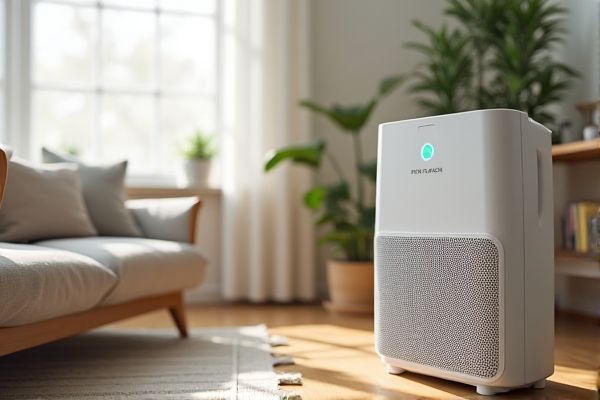
A humidifier adds moisture to the air to relieve dryness and improve comfort, while a dehumidifier removes excess moisture to prevent mold, mildew, and allergy issues. Understanding the differences between these devices helps you maintain optimal indoor air quality; keep reading to discover which is best for your needs.
Table of Comparison
| Feature | Humidifier | Dehumidifier |
|---|---|---|
| Purpose | Adds moisture to the air | Removes moisture from the air |
| Ideal Use | Dry indoor environments, dry skin, respiratory issues | High humidity areas, mold prevention, allergy control |
| How It Works | Releases water vapor or steam | Extracts water vapor and collects it in a tank |
| Common Types | Ultrasonic, evaporative, steam vaporizer | Refrigerant, desiccant, thermoelectric |
| Benefits | Improves air quality, prevents dryness, soothes respiratory tract | Reduces mold, prevents dust mites, controls humidity levels |
| Drawbacks | Can cause excess moisture if overused | Consumes more electricity, needs regular emptying |
Introduction: Humidifier vs Dehumidifier
Humidifiers increase indoor humidity by releasing moisture into the air, making them ideal for dry climates or winter months when heating systems reduce humidity levels. Dehumidifiers remove excess moisture from the air, preventing mold growth and improving air quality in damp or humid environments. Understanding the specific needs of your space will help you choose between a humidifier and a dehumidifier for optimal comfort and health.
Understanding Indoor Humidity
Indoor humidity levels directly impact comfort, health, and the preservation of household items, making it essential to maintain a balanced environment. Humidifiers add moisture to dry air, preventing issues such as dry skin, respiratory irritation, and static electricity, especially during winter months or in arid climates. Dehumidifiers remove excess moisture, reducing mold growth, dust mites, and musty odors, thereby improving air quality and preventing structural damage in humid or damp conditions.
What Is a Humidifier?
A humidifier is a device designed to increase indoor humidity by releasing moisture into the air, which can help alleviate dry skin, nasal congestion, and respiratory discomfort. It is especially beneficial in dry climates or during winter months when heating systems reduce indoor moisture levels. Your choice to use a humidifier can improve air quality, making your living space more comfortable and healthier.
What Is a Dehumidifier?
A dehumidifier is an electrical appliance designed to reduce and maintain the level of humidity in the air, typically for health or comfort reasons. It works by drawing moist air over cold coils, condensing the moisture, and collecting the water in a tank or draining it away. Dehumidifiers are commonly used in damp or humid environments to prevent mold growth, reduce allergens, and improve indoor air quality.
Key Differences Between Humidifiers and Dehumidifiers
Humidifiers add moisture to the air, increasing indoor humidity levels to alleviate dryness, while dehumidifiers remove excess moisture, reducing humidity to prevent mold and mildew growth. Humidifiers are ideal for dry climates or during winter when indoor air tends to be dry, whereas dehumidifiers are essential in damp environments prone to excess moisture. Both devices improve indoor air quality but serve opposite purposes in maintaining optimal humidity levels between 30% and 50%.
Benefits of Using a Humidifier
A humidifier increases indoor moisture levels, helping to alleviate dry skin, irritated respiratory passages, and static electricity during colder months. It supports respiratory health by preventing dryness that can lead to coughs, sore throats, and sinus irritation. Your indoor air quality improves, creating a comfortable environment that can also help preserve wooden furniture and prevent cracking.
Advantages of a Dehumidifier
A dehumidifier effectively reduces excess moisture in indoor air, preventing mold growth and improving overall air quality. It helps alleviate allergy and asthma symptoms by removing dust mites and allergens that thrive in humid environments. Using a dehumidifier also protects furniture, electronics, and structural elements from humidity-related damage, extending their lifespan.
When to Use a Humidifier vs a Dehumidifier
Use a humidifier when indoor air feels dry, especially during winter months or in arid climates, to maintain ideal humidity levels between 30% and 50%. A dehumidifier is essential if your home experiences excess moisture, mold growth, or musty odors, typically in basements or humid environments, to reduce humidity below 50%. Assessing your space's humidity with a hygrometer helps you decide whether your air needs added moisture or moisture removal for optimal comfort and health.
Factors to Consider Before Choosing
Consider your local climate and indoor humidity levels when choosing between a humidifier and dehumidifier, as humidifiers add moisture while dehumidifiers remove excess dampness. Assess specific needs such as allergy relief, mold prevention, or comfort improvement, since each device targets different air quality issues. Your decision should also factor in room size, maintenance requirements, and energy consumption to ensure efficient, effective humidity control.
Conclusion: Which One Is Right for You?
Choosing between a humidifier and a dehumidifier depends on the specific humidity levels in your living space and personal comfort needs. A humidifier is ideal for dry environments or during winter months to add moisture and alleviate dry skin, respiratory issues, and static electricity. In contrast, a dehumidifier suits damp or humid areas by reducing excess moisture, preventing mold growth, and improving air quality, making it the right choice for basements or humid climates.
 homyna.com
homyna.com